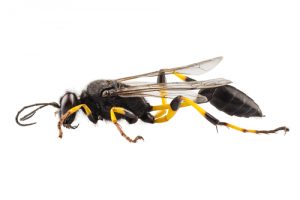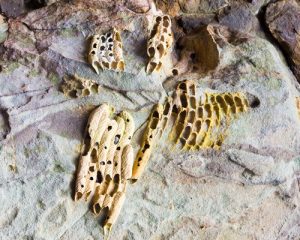How Do Mud Daubers Build Their Nests?
By Chris Williams on May 10, 2012.
Q. I have a question about those wasps that build the mud tube nests on houses. How do they get the mud to make the nests?
A. You’re talking about mud dauber wasps, also sometimes called dirt daubers. They get their name because of their unique nests that are made of mud tubes. To start her nest, the female mud dauber finds a protected, shady site near a potential supply of mud. Nests are most often built on flat wood surfaces, but also on concrete or cement. She then visits an area that has mud of just the right consistency. She usually visits two or more sites to collect mud, which means the mud tubes, can have different colors depending on the type of soil used. Clay soil is her favorite. She uses her mandibles (jaws) to scrape up soft mud, which she rolls into a small ball that is held between her front legs as she flies off.
 At the nest site, she presses the mud ball into position using her head and mandibles, smoothing it out with her saliva to shape it into a short tube. She makes a high-pitched humming sound as she works. A single tube can have several sealed chambers inside, each chamber requiring 30 to 40 loads of mud, and each containing a mud dauber larva. Our most common type of mud dauber is called the organpipe mud dauber because the mud tubes attached together look like the parallel pipes of an organ. The completed nest of this wasp consists of several tubes, up to 8 inches long, built side by side.
At the nest site, she presses the mud ball into position using her head and mandibles, smoothing it out with her saliva to shape it into a short tube. She makes a high-pitched humming sound as she works. A single tube can have several sealed chambers inside, each chamber requiring 30 to 40 loads of mud, and each containing a mud dauber larva. Our most common type of mud dauber is called the organpipe mud dauber because the mud tubes attached together look like the parallel pipes of an organ. The completed nest of this wasp consists of several tubes, up to 8 inches long, built side by side.
As the female mud dauber constructs each chamber or brood cell in her nest, she also has to provision it with orb-weaving spiders for her young to feed on. She stings the spiders to paralyze them and stuffs them into the cell, usually 3 to 9 spiders per cell. She doesn’t kill the spiders because they need to be still alive and fresh when her eggs hatch. After she lays an egg in each provisioned cell, she applies mud to seal that cell and then begins on the next cell in the tube.
The whole nest building process can take from 3 hours to 2 to 3 days. It usually ends when the wasp runs out of spiders or energy. During this nest building process, the female does all the work. The male remains in the nest, guarding it to make sure that no parasites get into the nest cells before they are sealed.
 Although mud daubers frequently build their nests right on our front porches, they are not aggressive and won’t sting unless they’re handled or harassed. They’re interesting creatures to observe. If you carefully scrape a mud dauber’s nest off of the surface using a putty knife, and turn it over, you can see the exposed back side of the nest cells. If it’s a newly completed nest where the eggs have just been laid, you will see that each cell is packed with spiders. In an older nest, you might see the wasp larvae in each cell feeding on their spiders. After several days of feeding, the larvae pupate inside their chambers. If the nest has been around since last year, the chambers will probably be empty and you can see round exit holes in the mud where the adult wasps emerged in early spring.
Although mud daubers frequently build their nests right on our front porches, they are not aggressive and won’t sting unless they’re handled or harassed. They’re interesting creatures to observe. If you carefully scrape a mud dauber’s nest off of the surface using a putty knife, and turn it over, you can see the exposed back side of the nest cells. If it’s a newly completed nest where the eggs have just been laid, you will see that each cell is packed with spiders. In an older nest, you might see the wasp larvae in each cell feeding on their spiders. After several days of feeding, the larvae pupate inside their chambers. If the nest has been around since last year, the chambers will probably be empty and you can see round exit holes in the mud where the adult wasps emerged in early spring.
One type of mud dauber, the blue mud dauber, is especially interesting. It waits until another mud dauber has completed her nest. Then the blue mud dauber carries water to the nest so that she can moisten it enough to open up a brood chamber. She empties the chamber of spiders and the other wasp’s egg. Then she deposits her own paralyzed spiders (usually black widows!), lays her own egg, and seals the chamber up again. Instant nest with half the work!